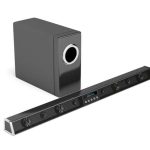Bass music is thrilling! Did you know the eminence of sound is as essential as the message passing across? And your sensitivity to bass is adequate at high levels?
Well, in your daily activities from childhood, you may have preferred listening to tunes and watching movies and TV shows on bass. Bass music has a way of drawing us in.
So, what happens when you spend several bucks to purchase a subwoofer only to find out that the bass keeps fading when you turn up the volume? There are many possibilities of what’s causing the distorted sound quality.
Stick around to understand and find out possible solutions. But first,
Why it Bothers You When the Bass in Your Subwoofer Fades
While it is a common thought that bass music is exciting, there is a more scientific drill to it—your brain.
Several years ago, McMaster University studied to demystify how human brains react to low-pitched and high-pitched sounds. The reaction to low-level sounds was immense.
It is why you’ve always found yourself nodding to bass tones, even when you’re not so familiar with the song’s words.
Every time your subwoofer sounds bad at high volumes or fails to keep up with the bass, your brain fails to take up the pitch as it should. And the result—you’ll not revel in your tones.
Why My Subwoofer Bass Fades When Turning Up Volume
The fading of subwoofer bass with high volume is a common subwoofer problem. And there are several reasons your subwoofer bass fades when turning up the volume, as discussed below. So, try applying the solutions stated, and maybe you’ll have your answers. Let’s go
1. Are You on Parallel Connection?
Maybe your subwoofer is connected in parallel to your amplifier’s speaker wires. So, if you turn up the volume on your amp, you will boost the voltage of those speaker wires. It will cause a voltage drop across them. The current through these wires will also drop, creating an impedance mismatch that can make a large amount of distortion.
To fix this issue, try connecting your subwoofer directly to an external power supply with enough power to maintain full-range performance without distortion.
2. Low Power Output
Bass fades because there are only enough watts of power available in each speaker system. The other speakers use more energy as you increase the volume. In this case less and less energy is left for the subwoofer.
Therefore, you need to set your subwoofer’s crossover frequency correctly. The crossover frequency determines how much power goes into each speaker. So, by adjusting it perfectly, you can ensure that the right amount of energy goes into your subwoofer and not into any other speakers.
3. What’s Your Subwoofers Rated Power?
The maximum amount of power that a speaker can put out without damaging it is called its “rated power.” Increasing your stereo too loud will damage your speakers if they’re not rated for that kind of power. You’ll also get distortion in your music if the volume is too high.
One way to check if your speakers can handle extra volume is to play a song with moderate levels at low volume— maybe one with quiet parts or ones that don’t use all the available frequencies. Then you’ll know what kind of sound quality you’ll get with more complicated songs later if everything goes well.

4. The Wire Gauge Size
Have you already tried out the above options, and still, the subwoofer bass fades when turning up the volume? Maybe you need a bigger-sized wire gauge.
When setting up the amp, the wires directly impact the bass output. Make sure you have an excellent ground connection by balancing the speaker wires with the gauge wire.
If one of the wires is thicker than another, it will cause an imbalance in the signal and cause interference. Thicker wires ensure the power demand meets comfortably.
Other Common Subwoofer Problems
Subwoofer problems are many. You may think that your subs cut out at high volume due to the connection, power, or gauge size, but your challenges may differ.
1. My Bass Keeps Cutting in And Out
Your bass may cut out if you have a bad connection between your amp and the speaker. Try changing the links and make sure they aren’t loose.
When the current draw gets too high, the subwoofer will cut out until it’s satisfied with its signal level.
Therefore, some people find their subwoofers cutting out after turning up the volume on their car stereo or home stereo system. And this is a sign that the subwoofers can’t keep up with the volume you’re playing. It may be as a result of low-quality speakers or an over-enthusiastic amplifier.
The best way to fix this problem is through simple adjustments to your subwoofer’s settings.
You can try adjusting the bass level on your amplifier until you find the perfect balance between volume and quality. If you don’t want to interfere with settings, you can also try using a different speaker setup or another amplifier altogether.
2. Low Bass Output
Low bass output means the subwoofer isn’t producing enough low-frequency sound. You may notice that the subwoofer doesn’t produce any noticeable bass. If you have a subwoofer that’s not making enough bass, it could be due to several reasons.
- Ensure that the volume control is up all the way.
- Check if the subwoofer plugs into the correct input jack. If it is, then connect another input jack.
- Make sure that the subwoofer sets to its lowest setting.
- Confirm that the amplifier can handle the power requirements of the subwoofer.
3. High Impedance
Overload to the subwoofers’ internal circuitry is what’s called high impedance. It causes distortion and poor performance. You’ll need to replace the subwoofer’s internal components to fix this problem.
4. Weak Magnets
Weak magnets mean that the subwoofer’s voice coils aren’t strong enough to pull the diaphragm back down after being pushed up. It results in a lack of bass.
5. Loose Connections
When the subwoofers are loosely connected, damage to the subwoofer’s circuit board is inevitable. Check the subwoofer and amplifier connections. Make sure that they’re tight and secure.
6. Dirty Voice Coil
Quality sound is impeded when voice coils have dirt and debris. Cleaning them will help improve their efficiency.
7. Bad Enclosure
If the subwoofer’s enclosure is damaged, then it won’t be able to dissipate heat properly. It will result in overheating and failure.
Now you’re set to solve the common subwoofer problems and enjoy your bass music at high levels without cutting in and out. You don’t need to know it all, give it a try with this simple guide!
Michael Evanchuk is a San Francisco-based sound engineer with 20 years’ experience installing, troubleshooting, and repairing commercial, automotive, and household sound equipment. Evanchuk owns an auto stereo center, where he offers highly competitive car audio installation and repair services. He has written dozens of articles on different sound engineering topics, all of which have been published in leading journals, blogs, and websites.






